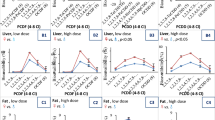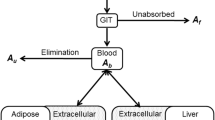Abstract
Concentrations of 2,3,7,8-tetrachlorodibenzo-p-dioxin (TCDD) in rat liver and adipose tissue, and hepatic ethoxyresorufin O-deethylase (EROD) activity were studied subsequent to a single subcutaneous injection of TCDD. Two types of experiments were performed to study: (a) time-dependent changes following a single injection of 300 ng TCDD/kg body wt (points 1–4), and (b) dose-dependent changes measurable after 7 days following a single injection (points 5–7).
-
1.
Absorption of TCDD following a single subcutaneous injection was about 90% after 3 days and 98% after 5 days.
-
2.
Following a single dose of 300 ng TCDD/kg body wt peak concentrations were: liver (after 3 days): 4.7±0.9 ng/g wet wt, and adipose tissue (after 7 days): 0.82±0.07 ng/g wet wt.
-
3.
T1/2 of TCDD in liver was 13.6 days over the total experimental period (from day 10 to 91 of the study), apparently with an initial faster phase: 11.5 days (from day 10 to 49), and a slower period at the end of the experiment: 16.9 days (from day 49 to 91); in adipose tissue the t1/2 was 24.5 days (from day 14 to 91 of the study).
-
4.
Maximum induction of EROD in the liver was observed (14-fold at 300 ng TCDD/kg body wt) 3–7 days following the injection; the activity was decreased to about one third of the maximum 3 weeks after the injection; increase in total cytochrome P-450 at this dose was only about 1.4-fold at the induction maximum.
-
5.
The ratio of the TCDD concentrations in liver and adipose tissue increased considerably between doses of 3 ng TCDD/kg body wt (ratio∶about 0.74) and 3000 ng TCDD/kg body wt (ratio∶about 7.7).
-
6.
The extent of EROD induction in the liver increased dose dependently. A significant effect was first observed with a dose of 3 ng TCDD/kg body wt (activity about +32% above control activity). The corresponding tissue concentration was about 10 pg TCDD/g liver wet wt.
-
7.
An almost perfect linear relationship exists (when using a double-log plot) between the hepatic TCDD concentration and the EROD activity for tissue concentrations ranging from 40 to 30 000 pg TCDD/g wet wt.
Similar content being viewed by others
Abbreviations
- TCDD:
-
2,3,7,8-tetrachlorodibenzo-p-dioxin
- EROD:
-
ethoxyresorufin O-deethylase
- AHH:
-
aryl hydrocarbon hydroxylase
References
Abraham K (1988) Untersuchungen zur Pharmakokinetik und enzyminduzierenden Wirkung von 2,3,7,8-Tetrachlorodibenzo-p-dioxin. Dissertation submitted to the Medizinische Fachbereiche, Freie Universität Berlin
Abraham K, Krowke R (1988) TCDD accumulation in rat liver and adipose tissue is dose-dependent. Naunyn-Schmiedeberg's Arch Pharmacol Suppl. 337: R28
Aitio A, Parkki MG (1978) Organ specific induction of drug metabolizing enzymes by 2,3,7,8-tetrachlorodibenzo-p-dioxin in the rat. Toxicol Appl Pharmacol 44: 107–114
Allen JR, Van Miller JP, Norback DH (1975) Tissue distribution, excretion and biological effects of 14C-tetrachlorodibenzo-p-dioxin in rats. Fd Cosmet Toxicol 13: 501–505
Berry DL, Zachariah PK, Namkung MJ, Juchau MR (1976) Transplacental induction of carcinogen-hydroxylating systems with 2,3,7,8-tetrachlorodibenzo-p-dioxin. Toxicol Appl Pharmacol 36: 569–584
Burke MD, Mayer RT (1974) Ethoxyresorufin: direct flurometric assay of a microsomal O-dealkylation which is preferentially inducible by 3-methylcholanthrene. Drug Metab Dispos 2: 583–588
Burke MD, Prough RA, Mayer RT (1977) Characteristics of a microsomal cytochrome P-488-mediated reaction, ethoxyresorufin O-deethylase. Drug Metab Dispos 5: 1–8
Burke MD, Thompson S, Elcombe CR, Halpert J, Haaparanta T, Mayer RT (1985) Ethoxy-, Pentoxy- and benzyloxyphenoxazones and homologues: a series of substrates to distinguish between different induced cytochromes P-450. Biochem Pharmacol 34: 3337–3345
Cantoni L, Rizzardini M, Belvedere G, Cantoni R, Fanelli R, Salmona M (1981) Induction of mixed-function oxidase by chronic treatment with 2,3,7,8-tetrachlorodibenzo-p-dioxin in female rats. Toxicology 21: 159–167
Facchetti S, Fornari A, Montagna M (1980) Distribution of 2,3,7,8-tetrachlorodibenzo-p-dioxin in the tissues of a person exposed to the toxic cloud at Seveso. Adv Mass Spectr 8B: 1405–1414
Fries GF, Marrow GS (1975) Retention and excretion of 2,3,7,8-tetrachlorodibenzo-p-dioxin by rats. J Agr Food Chem 23: 265–269
Gonzalez FJ, Tukey RH, Nebert DW (1984) Structural gene products of the Ah locus; transcriptional regulation of cytochrome P1-450 and P3-450 mRNA levels by 3-methylcholanthrene. Mol Pharmacol 26: 117–121
Kitchin KT, Woods JS (1979) 2,3,7,8-Tetrachlorodibenzo-p-dioxin (TCDD) effects on hepatic microsomal cytochrome P-448-mediated enzyme activities. Toxicol Appl Pharmacol 47: 537–546
Klotz AV, Stegeman JJ, Walsh C (1984) An alternative 7-ethoxyresorufin O-deethylase activity assay: a continuous visible spectrometric method for measurement of cytochrome P-450 monooxygenase activity. Anal Biochem 140: 138–145
Kociba RJ, Keeler PA, Park CN, Gehring PJ (1976) 2,3,7,8-Tetrachlorodibenzo-p-dioxin (TCDD): results of a 13-week oral toxicity study in rats. Toxicol Appl Pharmacol 35: 553–574
Kociba RJ, Keyes DG, Beyer JE, Carreon RM, Wade CE, Dittenber DA, Kalnins RP, Frauson LE, Park CN, Barnard SD, Hummel RA, Humiston CG (1978) Results of a two-year chronic toxicity and oncogenicity study of 2,3,7,8-tetrachlorodibenzo-p-dioxin in rats. Toxicol Appl Pharmacol 46: 279–303
Krowke R (1986) Studies on distribution and embryotoxicity of different PCDDs and PCDFs in mice and marmosets. Chemosphere 15: 2011–2022
Lakshmanan MR, Campbell BS, Chirtel SJ, Ekarohita N, Ezekiel M (1986) Studies on the mechanism of absorption and distribution of 2,3,7,8-tetrachlorodibenzo-p-dioxin in the rat. J Pharmacol Exp Ther 239: 673–677
Lucier GW, Rumbaugh RC, McCoy Z, Hass R, Harvan D, Albro P (1986) Ingestion of soil contaminated with 2,3,7,8-tetrachlorodibenzo-p-dioxin (TCDD) alters hepatic enzyme activities in rats. Fund Appl Toxicol 6: 364–371
Matsubara T, Koike M, Touchi A, Tochino Y, Sugeno K (1976) Quantitative determination of cytochrome P-450 in rat liver homogenate. Anal Biochem 75: 596–603
Okey AB, Bondy GP, Mason ME, Kahl GF, Eisen HJ, Guenthner TM, Nebert DW (1979) Regulatory gene product of the Ah locus: characterization of the cytosolic inducer-receptor complex and evidence for its nuclear translocation. J Biol Chem 254: 11636–11648
Piper WN, Rose JQ, Gehring PJ (1973) Excretion and tissue distribution of 2,3,7,8-tetrachlorodibenzo-p-dioxin in the rat. Environ Health Perspect 5: 241–244
Poiger H, Schlatter C (1980) Influence of solvents and adsorbents on dermal and intestinal absorption of TCDD. Fd Cosmet Toxicol 18: 477–481
Poiger H, Schlatter C (1986) Pharmacokinetics of 2,3,7,8-TCDD in man. Chemosphere 15: 1489–1494
Poiger H, Pluess N, Schlatter C (1988) Subchronic toxicity of some chlorinated dibenzofurans in rats, (personal communication, Las Vegas Meeting on Dioxins)
Poland A, Glover E (1973) Studies on the mechanism of toxicity of the chlorinated dibenzo-p-dioxins. Environ Health Perspect 5: 245–251
Poland A, Glover E (1974) Comparison of 2,3,7,8-tetrachlorodibenzo-p-dioxin, a potent inducer of aryl hydrocarbon hydroxylase, with 3-methylcholanthrene. Mol Pharmacol 10: 349–359
Poland AP, Glover E, Robinson JR, Nebert DW (1974) Genetic expression of aryl hydrocarbon hydroxylase activity: induction of monooxygenase activities and cytochrome P1-450 formation by 2,3,7,8-tetrachlorodibenzo-p-dioxin in mice genetically “nonresponsive” to other aromatic hydrocarbons. J Biol Chem 249: 5599–5606
Poland A, Glover E, Kende AS (1976) Stereospecific high affinity binding of 2,3,7,8-tetrachlorodibenzo-p-dioxin by hepatic cytosol: evidence that the binding species is receptor for induction of aryl hydrocarbon hydroxylase. J Biol Chem 251: 4936–4946
Rose JQ, Ramsey JC, Wentzler TH, Hummel RA, Gehring PJ (1976) The fate of 2,3,7,8-tetrachlorodibenzo-p-dioxin following single and repeated oral doses to the rat. Toxicol Appl Pharmacol 36: 209–226
Ryan JJ, Schecter A, Lizotte R, Sun WF, Miller L (1985) Tissue distribution of dioxins and furans in humans from the general population. Chemosphere 14: 929–932
Ryan JJ, Lizotte R, Lewis D (1987) Human tissue levels of PCDDs and PCDFs from a fatal pentachlorophenol poisoning. Chemosphere 16: 1989–1996
Author information
Authors and Affiliations
Additional information
Data presented in this paper are part of the doctoral thesis of Klaus Abraham to be submitted to the Medizinische Fachbereiche, Freie Universität Berlin
Rights and permissions
About this article
Cite this article
Abraham, K., Krowke, R. & Neubert, D. Pharmacokinetics and biological activity of 2,3,7,8-tetrachlorodibenzo-p-dioxin. Arch Toxicol 62, 359–368 (1988). https://doi.org/10.1007/BF00293624
Received:
Accepted:
Issue Date:
DOI: https://doi.org/10.1007/BF00293624




